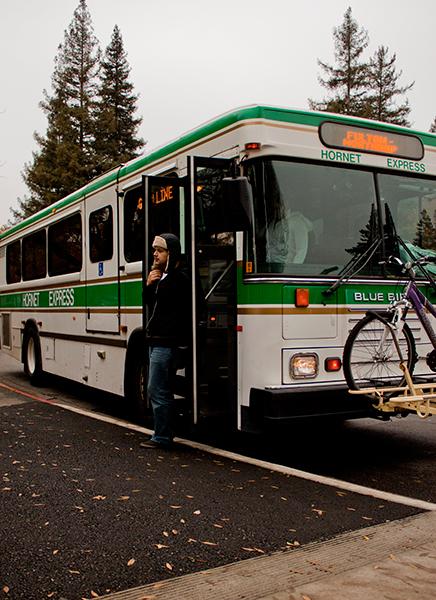ASI proposes to eliminate Hornet Line instead of Gold Line

Hornet Express :The Gold Line, which has the most ridership, could be eliminated in the fall.:Dan Ward – State Hornet
December 8, 2010
In response to the proposed cuts to the Hornet Shuttle, Associated Students Inc. proposed alternative solutions to the university’s Transportation Advisory Committee that involves cutting the Hornet Line instead of the Gold Line.
“If were talking about cutting lines, the Hornet Line goes around campus – everything on campus you can walk to,” said Chris Smith, ASI’s vice president of finance. “Also, the 82, 87, 34 (Regional Transit buses) go to light rail directly and you can walk though the Hornet Tunnel (to get there).
The University Transportation and Parking Services is proposing to eliminate the Hornet Shuttle’s early and late morning, midday and evening routes by spring and the Gold Line by fall. Abigail Stone, associate vice president of business and administrative services for UTAPS, said the proposed changes would save about $100,000 annually, allowing for the purchase or lease of new buses.
ASI’s proposal now goes to UTAPS for approval, and then to Sacramento State President Alexander Gonzalez for his signature.
ASI opposes elimination of the Gold Line because it has the highest ridership. Smith said spring 2010 figures show the Gold Line has 24,450 riders, while the Green and Hornet lines have 19,062 and 14,029 riders, respectively.
The Gold Line also covers routes that Regional Transit buses do not, Smith said.
Smith said the Gold Line covers the Heritage Lane/Point West area, where some students live and Regional Transit does not cover. It also goes to Howe and Northrop where there is only one Regional Transit bus every 30 minutes.
Stone said the Gold Line was chosen for elimination because the majority of its routes overlapped with Regional Transit. She said students can ride the Regional Transit for free with their OneCard and commuter pass sleeve from the OneCard Office.
The Green and Hornet lines, on the other hand, do not overlap because the Green Line services the area from La Riviera to Watt and along Folsom Boulevard and the Hornet Line goes to Folsom Hall and the 65th Street light rail station, Stone said.
She also said students who live in the Heritage Lane/Point West area can take the No. 22 bus stop on Arden Way near Heritage Lane and transfer to the No. 87 on Howe Avenue to get to Sac State.
But transferring buses can turn the 20-minute commute to campus into an hour, Smith said.
“We encourage students living in this area to look for opportunities to car pool to and from campus or to consider alternate locations to live next year if that opportunity is available to them,” Stone said.
Because students have yearlong leases at apartments near Heritage Lane/Point West, Stone said UTAPS would not eliminate the Gold Line until fall 2011.
ASI’s proposal said the Hornet Line should be considered for elimination because it has the most redundancy with Regional Transit. The Hornet Tunnel provides access to the Light Rail Station and students can get to areas within campus like Folsom Hall via the Hornet Night Shuttle.
Unlike the Hornet and Green lines, Smith said there are no redundancies with the Gold Line after it leaves the campus.
Danielle Hamel, a teacher credential student, agreed.
She said UTAPS should eliminate the Hornet Line because it stops at the light rail station, which is only a 15-minute walk from Sac State.
The proposal also said rather than eliminating the Gold Line, UTAPS should determine the Gold Line schedule around the Regional Transit schedule.
It also said UTAPS needs to evaluate cutbacks on a per-route basis and time-per-time basis rather than cutting routes and schedules in a block.
“(UTAPS’) assumption in cutting in blocks like this assumes (students are) going to share rides in some other way, that’s not necessarily true; they might take their own cars and the whole point in ride sharing is clearing up the roads and making our environment a better place,” Smith said.
By reducing the Hornet Shuttle routes, students would not only have limited options to get to campus, but the jobs of the student bus drivers would be affected as well, Smith said.
ASI President Terry Martin said he has received many calls from students who do not want the Gold Line cut.
“It’s rare for me to receive this level of feedback from students unless the issue is fee increases, so it’s important to me that we do what we need to in order to keep the bus route running,” Martin said.
Charity King, sophomore art and biology major, said with the recent sexual assaults on campus, cutting back on the Hornet Shuttle would be inconvenient and dangerous.
King, who lives at the Upper East Side Lofts, said although she can use the Hornet Tunnel to get to the light rail station and to the lofts, she would rather use the campus resources if she has a late class or if it is raining.
Stone said UTAPS is reviewing the Hornet Line route for efficiency including the sections of its route that overlap with the Green Line and Regional Transit.
Michelle Curtis can be reached at [email protected].















































































































































